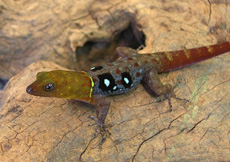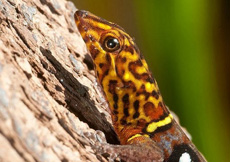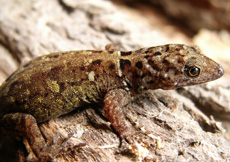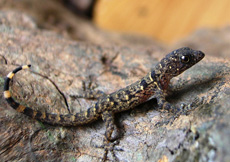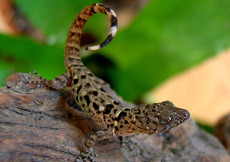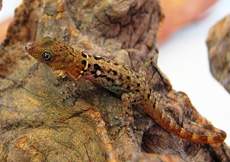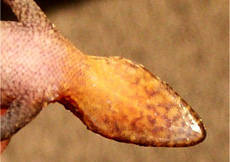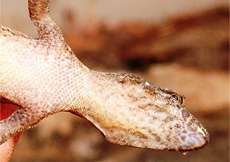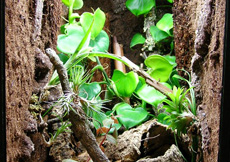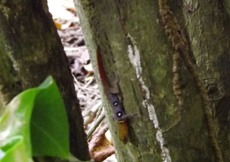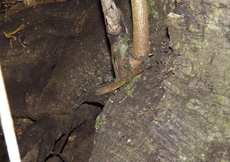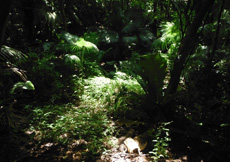Gonatodes ocellatus
(GRAY, 1831)
Distribution:
Gonatodes ocellatus occurs on Trinidad, Tobago and Little Tobago Island.
Description:
Gonatodes ocellatus males reach a total length of about 11 centimeters, making them known as one of the larger members of the genus. Females remain slightly smaller, usually less than 10 centimeters. Like all other females in the genus Gonatodes, females are colored pretty plainly. The females base color is brownish-gray with some lighter and darker spots and patterns. As usual the males are beautifully colored. The base color of their body is gray-blue to brown. Their two black-bordered, lateral ocelli, are usually light blue to white, which owes to its Latin name (In Latin Ocellatus means to be provided with eyes). The head and tail may have rust colored stains varying from yellow to orange and back to yellow. In most cases the base color of the head is a yellowish color, with a reddish-orange pattern. Around their neck is a yellow ring, lined with a black border. The neck ring is often interrupted dorsally. Young animals share the same color as the females, however they are more strongly contrasted and have a black and white tail. This is primarily to protect against predators, which will focus instead on the distinctive tail and attack only at this point. Since the tail can easily grow back, this makes for a very effective strategy that is found not only in Gonatodes, but other genera as well. After a few months, young males begin to show the classic eye spots.
Habitat:
Gonatodes ocellatus lives in humid micro-climates of primary and secondary forests, which are composed mostly of stems and roots. The species is also found on walls and roadsides. Gonatodes ocellatus does not appear to be synanthropic.
Husbandry and Breeding:
Taking the size of this "Dwarf Gecko" greatly in to consideration. For a pair, a terrarium measuring a minimum of 30x30x60 centimeters is recommended. Since they are active both on the walls and ground, the terrarium must be designed with this in mind. Gonatodes ocellatus are extremely agile and skillful climbers, therefore back walls of cork tiles or "schwarzcork" (black-cork tiles) will be greatly accepted by them. In a well structured and planted terrarium Gonatodes ocellatus will readily display their natural behavior. Cork tubes and branches offer additional space and cover. In the wild Gonatodes ocellatus is known to be rather shy, so be sure to provide enough cover and hiding places that may be reached quickly if needed. Following this advice, this species can be observed very well in captivity. For example, large pieces of cork bark and cork tubes should be randomly placed against the back wall. Such hiding spots will be very popular and often you can observe the geckos sitting on them, so if they need to quickly run from danger (even you) they may do so. Any plants used in the terrarium should be suited for small terrariums. Such plants include Tillandsia, Bromeliads, Peperomia and other small creeping/climbing plants, ferns and miniature orchids. Daytime temperatures should be kept between 25-28°C (77-82.4°F), however they are able to tolerate significantly higher temperatures for a short period of time. A localized heat spot may be provided, but care should be taken to make sure this location never goes above 40°C (104°F). Suitable for this purpose is a halogen puck light, which not only provides heat, but a bit of light for the geckos. In its natural habitat Gonatodes ocellatus forms several square meter districts. Males and females are generally incompatible with each other, therefore they are best housed only in pairs. Males and females should be separated for 1-2 months, per year to allow the females to regenerate from the breeding season. Every 3-4 weeks the females lay a single egg, often under bark, leaves or moss. It is also common for the females to bury their eggs in moderately moist soil. Unless you know the actual location, it is usually difficult to find the eggs. So ff you happen to witness the egg laying, you may have luck to find the egg in the same place the next time. If the conditions are right, the young will hatch just fine in the terrarium. The parents do not seem to mind the hatchlings, so you do not have to worry if you do not find the eggs. The hatchlings can be raised in converted household containers either in small groups or individually. Suitable food for Gonatodes ocellatus consists of, Drosophila, Springtails, Isopods, Firebrats, Bean Beetles, Pinhead crickets, Miniature Wax Moths as well as their larvae, Beetle larvae and finally Field Sweepings in the appropriate size. The young may also be fed the same diet as the parents. All food, with the exception of Field Sweepings should be dusted with the appropriate vitamins at every feeding!
Gonatodes ocellatus is one of the most prestigious members of the genus and can easily be kept and bred.
